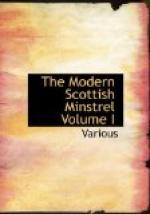In cotillions the French excel,
John Bull loves
country dances;
The Spaniards dance fandangoes
well;
Mynheer an all’mande
prances;
In foursome reels the Scots
delight,
At threesomes they dance wondrous
light,
But twasomes ding a’
out o’ sight,
Danced to the
reel o’ Bogie.
Come, lads, and view your
partners weel,
Wale each a blythesome
rogie;
I’ll tak this lassie
to mysel’,
She looks sae
keen and vogie.
Now, piper lads, bang up the
spring,
The country fashion is the
thing,
To pree their mou’s
ere we begin
To dance the reel
o’ Bogie.
Now ilka lad has got a lass,
Save yon auld
doited fogie,
And ta’en a fling upon
the grass,
As they do in
Strabogie.
But a’ the lasses look
sae fain,
We canna think oursel’s
to hain,
For they maun hae their come
again,
To dance the reel
o’ Bogie.
Now a’ the lads hae
done their best,
Like true men
o’ Strabogie,
We ‘ll stop a while
and tak’ a rest,
And tipple out
a cogie.
Come now, my lads, and tak
your glass,
And try ilk ither to surpass,
In wishing health to every
lass,
To dance the reel
o’ Bogie.
MRS GRANT OF CARRON.
Mrs Grant of Carron, the reputed author of one song, which has long maintained a favoured place, was a native of Aberlour, on the banks of the Spey, in the county of Banff. She was born about the year 1745, and was twice married—first, to her cousin, Mr Grant of Carron, near Elchies, on the river Spey, about the year 1763; and, secondly, to Dr Murray, a physician in Bath. She died at Bath about the year 1814.
In his correspondence with George Thomson, Burns, alluding to the song of Mrs Grant, “Roy’s Wife,” remarks that he had in his possession “the original words of a song for the air in the handwriting of the lady who composed it,” which, he adds, “are superior to any edition of the song which the public has seen.” He subsequently composed an additional version himself, beginning, “Canst thou leave me thus, my Katie?” but this, like others of the bard’s conversions of Scottish songs into an English dress, did not become popular. The verses by his female friend, in which the lady is made to be the sufferer by misplaced affection, and commencing, “Stay, my Willie, yet believe me,” though published, remain likewise in obscurity. “Roy’s Wife” was originally written to an old tune called the “Ruffian’s Rant,” but this melody is now known by the name of its favourite words. The sentiment of the song is peculiarly pleasing. The rejected lover begins by loudly complaining of his wrongs, and the broken assurances of his former sweetheart: then he suddenly recalls what were her good qualities; and the recollection of these causes him to forgive her marrying another, and even still to extend towards her his warmest sympathies.




